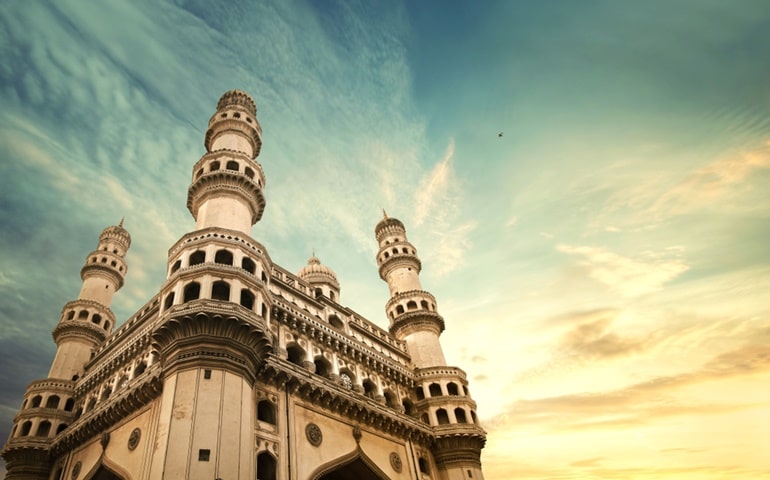Charminar is an iconic structure located in the capital city of Telangana, Hyderabad. It is built in Islamic architecture that has four minarets. There are many theories about why Char Minar was built. It is widely believed that Charminar was built to eradicate the spread of the epidemic Cholera. Inside the Charminar monument, there is a mosque at which people prayed to eradicate the epidemic that was hovering over the city. Let’s know more about Charminar tourism, history, architecture, and places to visit near Charminar India. This place is one of the famous tourist attraction spots in Hyderabad tourism.
- Charminar History
- Who Has Made Charminar?
- Information About Charminar Architecture
- Features Of Charminar Monument
- Interesting One Liner Charminar Facts
- Why Was The Charminar Built?
- What Is There To See In Charminar Monument?
- How Many Steps Are There In Charminar?
- How Many Years Did It Take To Build Charminar?
- What Is The Age Of Charminar?
- What Is Meant By Charminar?
- What Is Famous Charminar?
- Is Charminar A Mosque?
- What Rock Is Used To Make Charminar?
- Is Charminar A World Heritage Site?
- Charminar Timings
- Charminar Entry Fees(Ticket Price/ Cost)
- Places To Visit Near Charminar Monument
- Charminar Hyderabad Shopping
- How To Reach Charminar
- How To Reach Charminar By Metro
- Charminar Location
- Charminar Photos
1. Charminar History
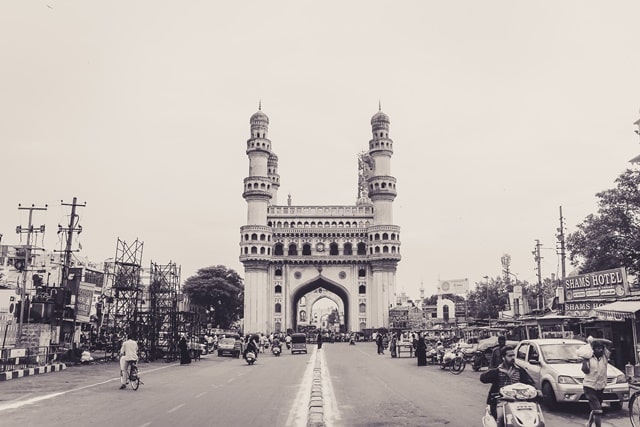
Charminar is known as Hyderabad ka Charminar and is a global icon in the city that many tourists visit yearly. It is built in the Indo-Islamic style of architecture. Charminar is located in the Old City of Hyderabad next to the famous Choodi Bazaar. It took one year to build Charminar monument. It is built in granite and limestone. This is a 400-year-old structure and it is said that there is a tunnel inside the Charminar that leads to the Golkonda Fort, though there is no evidence of it yet. Char Minar was built in 1591.
2. Who Has Made Charminar?
Charminar built by the 5th ruler of the Qutub Shahi dynasty, Mohammad Quli Qutub Shah. He had shifted his capital from Golconda to Hyderabad that is when he built this Charminar monument. It is built on the banks of River Musi. He founded the city of Hyderabad. He had planned the city of Hyderabad based on the Persian city Ispahan. He took the throne at the age of 15 and ruled the region for 31 years and built many iconic monuments.
There is a beautiful romantic story behind a few historic monuments in Hyderabad. Quli Qutub Shah fell in love with a Hindu girl called Bhagmati and married her after courting her for 11 years as there was strict opposition from his Muslim family. To meet her even during the storm and rain Purana Pul, a bridge was built so he could meet her despite the storm and rain. The city was named Bhagyanagar after her name and then changed to Hyderabad after Bhagmati changed to Islam after marriage and was called Hyder Mahal, so the name Hyderabad got its name after her. Quli Qutub Shah was a lover of poetry, was a poet himself, and loved fine arts and architecture. He developed the secular love and was known for his kindheartedness.
3. Information About Charminar Architecture
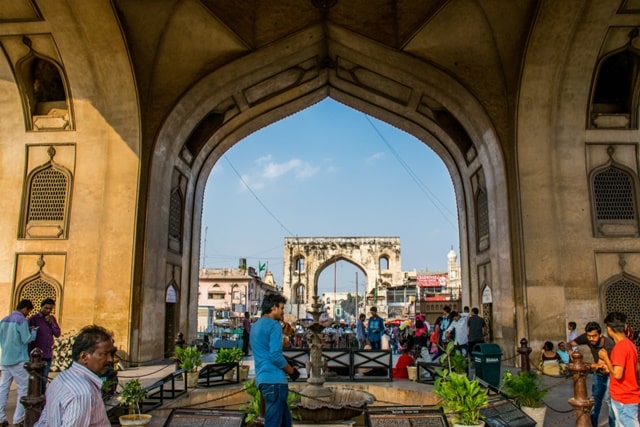
This iconic monument is two storey. The height of the Charminar monument is 48.7 meters, the minarets are 24 meters high and built in a square shape. The first floor has a balcony that provides an excellent view of the city. On the top floor, there is a mosque where prayers are still held. The dome of this monuments are built in Islamic style of architecture but the embellishments and ornamentation on these domes are done in Hindu style. At the base of the Charminar monument. There is a Hindu temple known as the Bhagyalakshmi temple.
4. Features Of Charminar Monument
- Four minarets represent the four leaders of Islam.
- Every minaret has 4 storeys and has a clock installed on them.
- Quli Qutub Shah planned the city of Hyderabad which he founded around Charminar.
- Two main roads intersect at the point of this monument.
- There are giant arches which have ornamentation on each side of the minaret.
- In the 18th century, giant clocks were installed inside each of these arches.
- There are 45 prayer spaces inside the gallery of Charminar.
5. Interesting One Liner Charminar Facts
Here is the list of facts about Charminar
- Prayers are held inside the mosque in Charminar every Friday.
- There are rumors that treasure is buried inside the secret passage between Charminar and Golconda.
- It was built to put an end to the epidemic plague that surrounded the city.
- Cat’s head is designed on one of the top bends of the monument on the eastern side to signify that the cats ate rats which put an end to the plague.
- Charminar is a solitary place that promotes secularism with a mosque inside and a temple at the base of this monument.
- It was also built in the loving memory of his wife Bhagmati.
- This structure survived the attack of Aurangzeb when he invaded the city and destroyed many monuments and structures.
6. Why Was The Charminar Built?
A plague hit the city during the 15th century due to lack of water in and around the Golkonda Fort. To protect the city from this plague, Quli Qutub Shah built Charminar monument and prayed inside the mosque to end the plague. It is believed that this monument marks the end of the deadly epidemic that had hit the city killing many people.
7. What Is There To See In Charminar Monument?
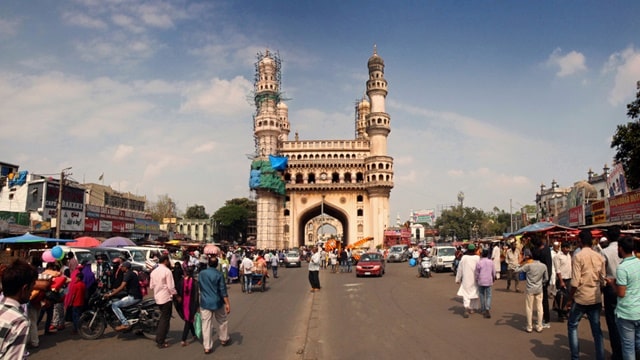
Inside Charminar, you can see the architecture, the motifs, and architecture of the monument. Surrounding the monument there is Laad Bazaar also known as Chudi Bazaar famous for buying bangles and pearls. Taste the famous Hyderabadi Haleem, Biryani, Irani Chai, and sweet dishes like Qubani Ka Meetha and Double Ka Meetha. Visit the markets nearby for shopping. These are the markets where you can bargain for a throw-away price and buy a lot of items.
8. How Many Steps Are There In Charminar?
The four minarets are built inside the main structure and not outside like that of Taj Mahal. Within each minaret, there are 149 steps to reach the top level of the Charminar monument. The monument has many decorations and motifs on each floor.
9. How Many Years Did It Take To Build Charminar?
Charminar was built between 1589 and 1591. It took two years to build this monument which lies in the heart of the city. Charminar is built in granite, limestone, and tons of marble powder. It is known for its elegance and Iranian architecture.
10. What Is The Age Of Charminar?
Today Charminar is 428 years old from the time it was built and stands to be the iconic structure of the city. Charminar was completed on 9th October 1591 and the city of Hyderabad was founded on the 9th October 1591, same day. It was designed by an Iranian architect Mir Momin Astrabadi.
11. What Is Meant By Charminar?
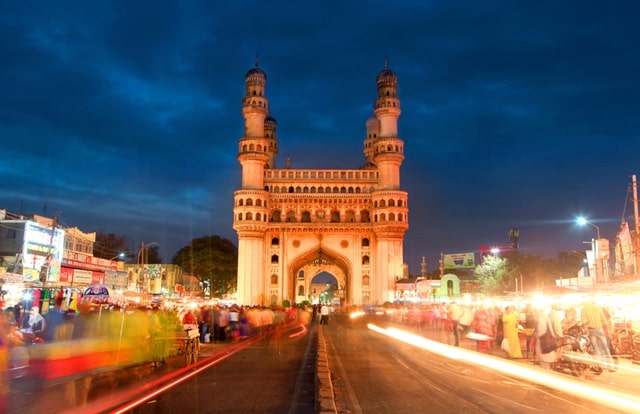
In Urdu, Char means ‘four’ and Minar means ‘tower.’ Each Minar signifies an Islamic leader. Charminar holds religious and historical significance. It also signifies love and romance between Quli Qutub Shah and Bhagmati.
12. What Is Famous Charminar?
It is the iconic structure of Hyderabad and represents the city. It is famous for its architecture and history surrounding it as the city was founded around this structure and hence holds a lot of significance. The Nizams who ruled the city post the invasion of Aurangzeb restored the lost charm of this structure to pay homage to Quli Qutub Shah.
13. Is Charminar A Mosque?
It is a monument as well as a mosque. There is a mosque inside the monument which is used for prayers even today. Every Friday prayers are held inside this mosque. It promotes peace, love, and religious tolerance.
14. What Rock Is Used To Make Charminar?
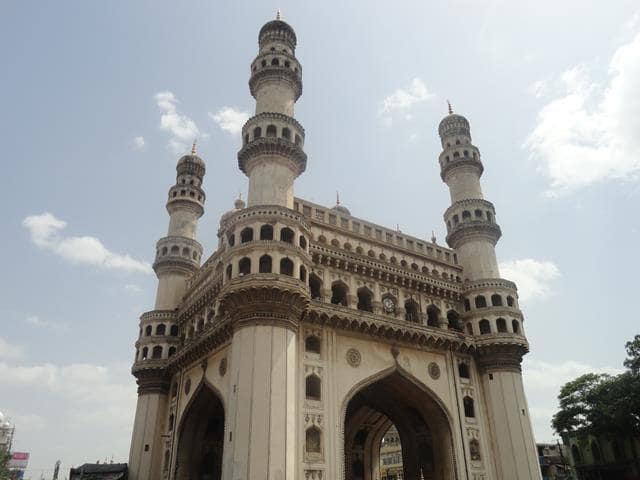
Charminar is made in granite, limestone and 14000 tons of marble powder. Unlike Taj Mahal, it is not made in marble, but a lot of marble powder has been used in the construction of this monument that is built mostly in the Iranian style with Hindu motifs.
15. Is Charminar A World Heritage Site?
Charminar is not yet a world heritage site as it is listed in the tentative list of the world heritage sites by the UNESCO. In 2010 the monument was submitted to UNESCO to consider it a world heritage site. It has not been given that title yet.
16. Charminar Timings
The Charminar entry starts at 09:30hrs up to 17:30hrs all day around the week.
17. Charminar Entry Fees(Ticket Price/ Cost)
Charminar ticket cost for Indian is 5 INR.
And Charminar ticket cost for foreign is 100 INR.
18. Places To Visit Near Charminar Monument
- Charminar street market
- Makkah Masjid, Hyderabad
- Chowmahalla Palace
- Tahniyat Mahal
- Nizam Museum Hyderabad
- Salar Jung Museum
19. Charminar Hyderabad Shopping
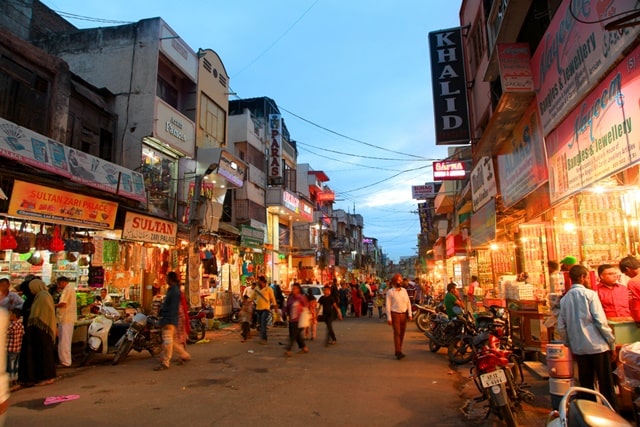
Hyderabad tourism is incomplete without visiting Charminar and Charminar street shopping bazaar. In the nearby Charminar markets, you can shop for the famous Hyderabad pearls, bangles, clothes, jooties, and many other items. Feel free to bargain for the price at this shopping street.
20. How To Reach Charminar
You can reach Charminar taking a local APSRTC local transportation which is 5 km from Hyderabad Bus Station. Within the city, you can take cabs, auto, and local trains to reach the nearby locations and take a walking tour around the monument.
21. How To Reach Charminar By Metro
There is no direct route to Charminar via metro, the nearest way to reach Charminar by metro is by taking the ride to MGBS metro station. Which is 3 km away from Charminar. Another nearest metro subway station is Malakpet, 5.8km away.
Read More: 16 Best Places To Visit In Hyderabad City: Tourist Place In Hyderabad Tourism
22. Charminar Location
23. Charminar Photos
Read More: Complete Information About The Gateway Of India Tourism

